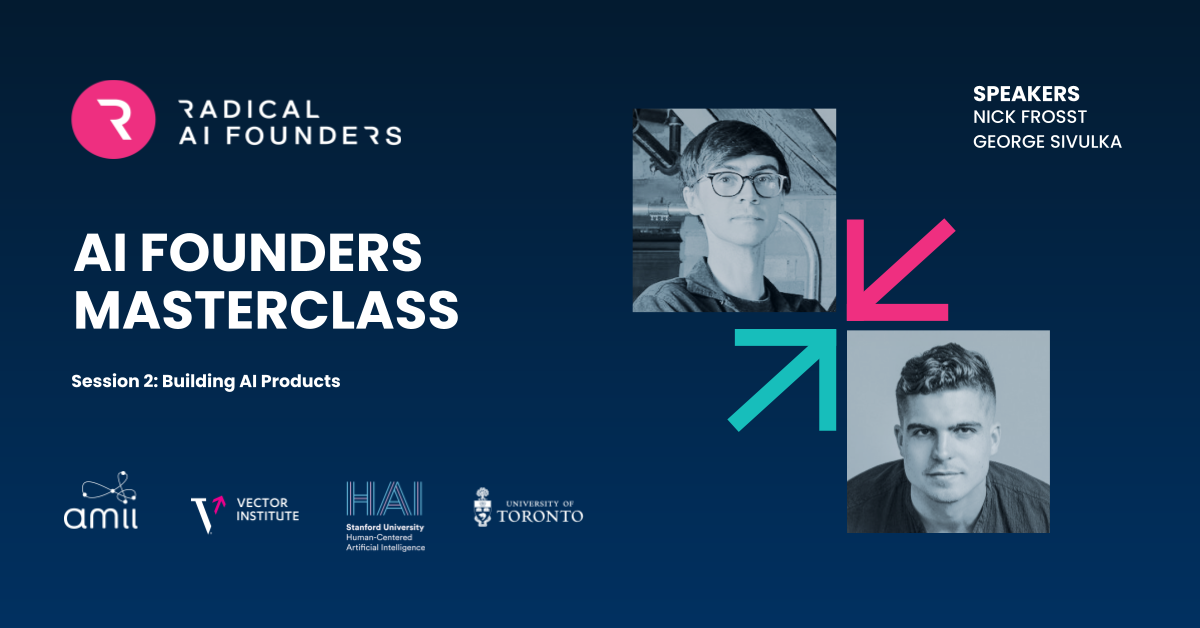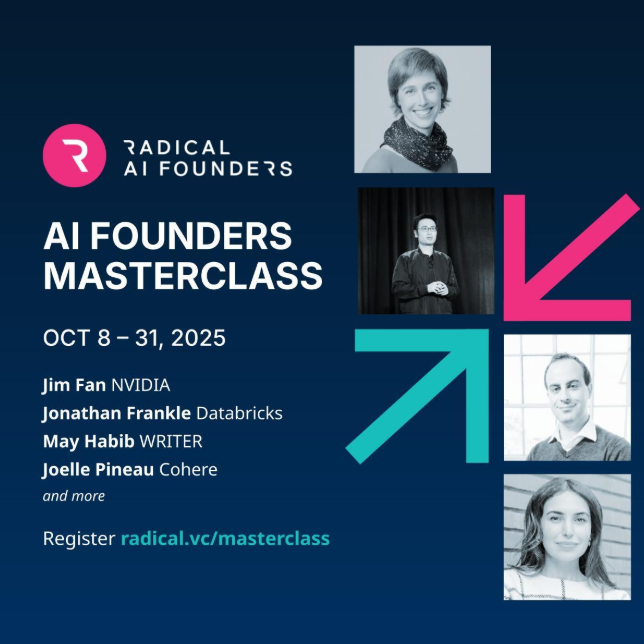The Radical AI Founders Masterclass returned this week with a discussion between Nick Frosst, co-founder of Cohere, and George Sivulka, founder and CEO of Hebbia. Their conversation, which focused on the important considerations founders need to address when building AI products, was moderated by Salim Teja, Partner at Radical Ventures. Please note that the excerpt below has been edited for conciseness and clarity.
Salim Teja: From your experience building software products, what are the nuances that differentiate the development of AI products from non-AI products?
George Sivulka: In the past, the prevailing belief was that AI should enhance an already great product rather than be the core feature itself. However, this perspective seems to be evolving, with many products now centered solely around AI.
In our experience at Hebbia, semantic search databases are great at finding answers within data, but users often ask questions about the data itself which is much more difficult to address. Hebbia spent many cycles solving this.
To build a successful AI product, it’s essential to focus on robust task decompositions, offer transparency and insights into AI’s decision-making process, and bridge the gap between the complexity of AI and user expectations of a product.
Salim Teja: We often talk about “product-market fit” in product strategy. In your own words, how would you describe the concept and how do you think about it within your teams?
George Sivulka: I think about product-market-fit as two vectors: one being what the market thinks it wants and the other being what your product actually offers. You want those vectors to be as closely aligned as possible.
In the field of AI especially, there is a third conflating vector– “narrative” fit– where customers want to feel excited about the story of their transformation with AI. Entrepreneurs should ask themselves, “Am I building a product that is actually serving a user’s needs, or are they buying a narrative?” Both are OK, but “narrative”-market fit is very different from “product”-market fit. Right now, narrative fit is very strong for AI products. Founders should delve into their metrics and have a clear understanding of which “fit” their product is achieving.
Salim Teja: We have an audience of researchers thinking about the journey to entrepreneurship and in some instances translating their research into product innovations. What advice would you give our audience on what the experience is like and what might be helpful for them to think about as they start the journey?
Nick Frosst: I often forget, but this (Cohere) is the second company that I’ve founded. The first company was based on an algorithm I was working on for saliency predictions – taking an image and predicting where people will look in that image. In short, it didn’t really work out. We eventually sold the product for around $20,000 which, as a university student was awesome, but it wasn’t the generational company that I’m excited about building now. It also wasn’t a failure.
If you try to spin your research into a company, and it fails, you’ll probably forget about it in a few years and that’s the worst it will be. Think about why it failed, and then if you want to try something else later, you will have learned. I learned that just because an algorithm or research innovation looks cool on paper, doesn’t make it useful. It turns out that people look at billboards and where they specifically look doesn’t really matter. It wasn’t a great product, but trying to do that didn’t set me back. That’s just to say – you should try.
AI News This Week
-
The AI 100 2023: The top people in artificial intelligence (Insider)
Insider’s AI 100 is a group of researchers, founders, and thinkers being celebrated for transforming business with AI, championing its ethical use, addressing its societal implications, and ensuring its responsible evolution. The 2023 list includes Geoffrey Hinton, AI luminary and investor in Radical Ventures, Daphne Koller, Founder and CEO of Insitro and a featured speaker at the forthcoming Radical AI Founders Masterclass. The list also spotlights founders from Radical Ventures’ portfolio: Raquel Urtasun of Waabi, Jason Koeller of Chemix, Himanshu Gupta of ClimateAi, and Aidan Gomez of Cohere.
-
Harvard Medical School and Oxford researchers develop AI tool to predict virus evolution (Nature)
An AI tool named EVEscape can forecast the emergence of new viral variants before they arise. The researchers show that had the tool been deployed at the start of the COVID-19 pandemic, EVEscape would have predicted the most frequent mutations and identified the most concerning variants for SARS-CoV-2. The tool analyzes vast evolutionary data, melded with intricate biological details about a virus, to predict potential future variants. As it continually tracks the evolution of SARS-CoV-2, the researchers release a biweekly ranking of emerging variants. Their overarching aim is to use these insights to develop “future-proof” vaccines and therapies, anticipating and countering virus mutations proactively.
-
Why AI Is medicine’s biggest moment since antibiotics (Wall Street Journal)
Dr. Lloyd Minor, dean of Stanford University School of Medicine, believes that neural networks and generative AI have the transformative power to reshape medical training, biomedical research, and healthcare delivery. Alongside Fei-Fei Li, co-director of the Stanford Institute for Human-Centered Artificial Intelligence and Radical Ventures Scientific Partner, Minor launched an initiative called Responsible AI for Safe and Equitable Health (Raise-Health). This project “aims to serve as a repository for key research, to gather experts to discuss AI and to tackle ethical concerns in its application.” Minor notes that young individuals entering medicine today are witnessing a groundbreaking era in medical transformation.
-
AI reads text from ancient Herculaneum scroll for the first time (Nature)
A 21-year-old undergraduate has unveiled a revolutionary method to decipher charred, sealed scrolls from ancient Herculaneum. By training a machine learning algorithm to detect minute ink-induced texture differences on unrolled scroll fragments, he successfully analyzed sealed scrolls using X-ray computed tomography scans. This innovation could reveal the hidden contents of countless writings buried by Mount Vesuvius in AD 79.
-
Research: AI can now sense smells with the Digital Map of Odors (Michigan State University/University of Pennsylvania/Google Research)
A collaborative team of researchers has developed a digital odour map, allowing AI to extend its capabilities beyond sight and sound to include the sense of smell. The paper reveals that machine learning can now quantify, digitize, and recreate scents. Using a Principle Odor Map (POM), the system surpassed human panellists in predicting odours from molecular structures in 53% of tests. This innovation opens a vast realm of ‘smell-ploration,’ allowing scientists to delve into a broader universe of odours beyond current fragrance catalogues. Future advancements could enable machines to perform superhuman tasks such as detecting health conditions through odours and replacing canines in high-risk tasks such as landmine detection.
Radical Reads is edited by Ebin Tomy (Analyst, Radical Ventures)





